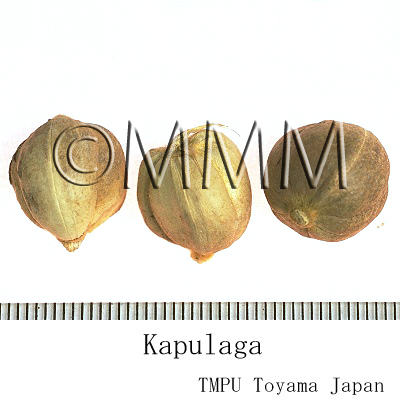Crude drug sample data base
※Click on the image to enlarge it.
Scientific information data base
| Crude drug name | Indonesian name, English name | Kapulaga | ||||
|---|---|---|---|---|---|---|
| crude drug image |
| |||||
| Original plant name | Amomum cardamomum Willd. | |||||
| Family name | Zingiberaceae | |||||
| Used part | Fruits | |||||
| Distribution area | A. cardamomum is a variety of cardamom that grows in Java (Indonesia) and other Malay Islands. In East Java it grows wild in mountainous regions and also cultivated in certain areas. In Sumatra (Indonesia) the plant grows either wild or cultivated [201]. | |||||
| Description | The plant is a perennial herb with a tuberous horizontal rhizome, stem bears alternate elliptical-lanceolate sheathing leaves. The flower stalk proceeds from the base of the stem and lies upon the ground with the flowers arranged in a panicle. The fruit is an ovoid, three-celled, loculicidally dehiscent capsule which contain many seeds covered by an aril. | |||||
| Drug effect | Bitter, warming, blood cleanser [231]. | |||||
| Specific actions | Carminative, expextorant [231]. | |||||
| Frequency in use | Moderate | |||||
| Pharmacological effect | Aqueous extract of cardamom may have component(s), which protect platelets from aggregation and lipid peroxidation [PMID:16106388]. Aqueous suspensions of cardamom have protective effects on experimentally induced colon carcinogenesis. Further studies have to be conducted before it is recommended for cancer prevention [PMID:16101317]. | |||||
| Medical system | Indonesian medicine (Jamu) | |||||
| Traditional usage | Fruits are used to treat tonsillitis, menstrual disorders, colic, gastritis, dyspnea, hoarseness, throat inflammation, as a carminative [222, 231]. Rhizomes are used to treat fever; as a tonic and deodorant [222]. Decoction of the whole plant is used as a tonic in weaknesess. Dried rhizome is powdered and drunk to warm the body. Decoction of fruits is used to cure spasm of the abdomen. Fruits are chewed to cure cough [201]. | |||||
| Formulation | 1) Foul breath: 10 pieces of cardamom fruits together with 1 handful of Centella asiatica leaves are mixed, add a certain amount of water and pounded to make a fine paste. Squeeze and drink 1/4 cup of the juice once a day in the morning for 7 days [231]. 2) Sore throat: 10 pieces of cardamom fruits, 6 grams of turmeric are steeped with 1000 ml of water. Strain and drink 100 ml of the tea twice a day for 7 days, [231]. | |||||
| References | Reference book Tips! | [201] K. Heyne, Tumbuhan Berguna Indonesia, Vols. 1-4, 1987. Diedarkan Oleh Koperasi Karyawan Departemen Kehutanan, Jakarta, Indonesia. Vol. 1, p 581. [222] P.T. Eisai Indonesia: Medical Herb Index in Indonesia (Second edition).1995. p 269. [231] Soedibyo, Mooryati: Alam Sumber Kesehatan: Manfaat dan Kegunaan (Natural resources for health. Benefits and uses). Balai Pustaka. 1998. pp 188-189. | ||||
| Research paper | 1. Suneetha WJ, Krishnakantha TP. Cardamom extract as inhibitor of human platelet aggregation. Phytother Res., 19(5):437-40, 2005. (PMID: 16106388) 2. Sengupta A, Ghosh S, Bhattacharjee S. Dietary cardamom inhibits the formation of azoxymethane-induced aberrant crypt foci in mice and reduces COX-2 and iNOS expression in the colon. Asian Pac J Cancer Prev., (2):118-22, 2005. (PMID: 16101317) | |||||
| Remarks | Fruits of Elletaria cardamomum are small and round; they are tastier and used to alleviate foul breath odour [201]. | |||||
| Last renewal date | 2024/03/15 | |||||





